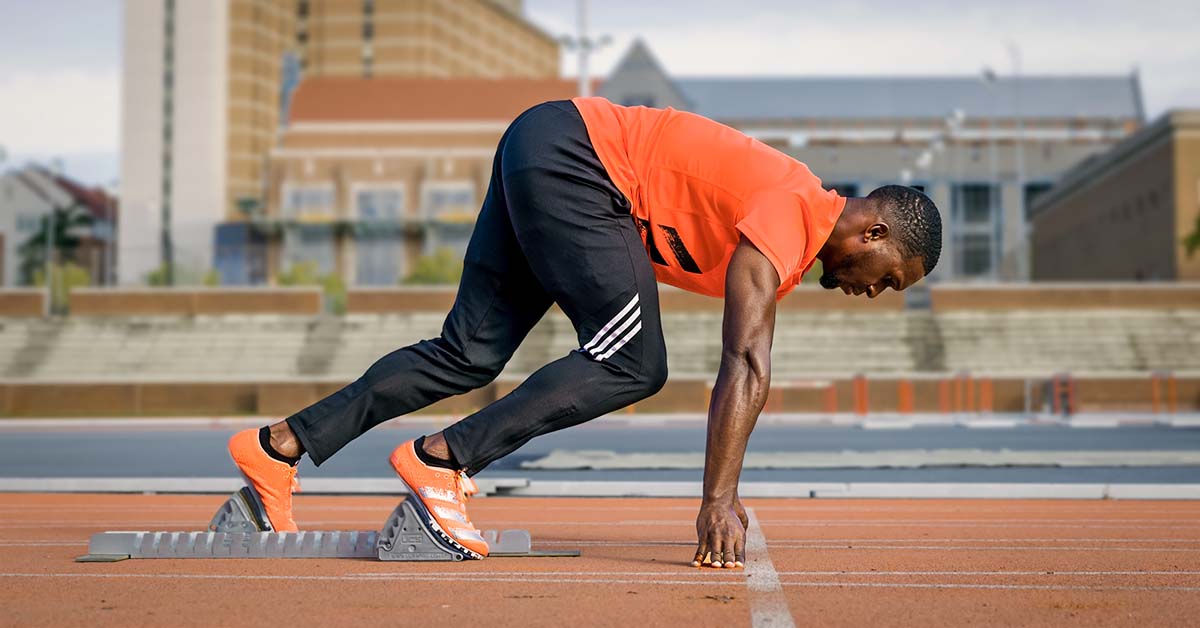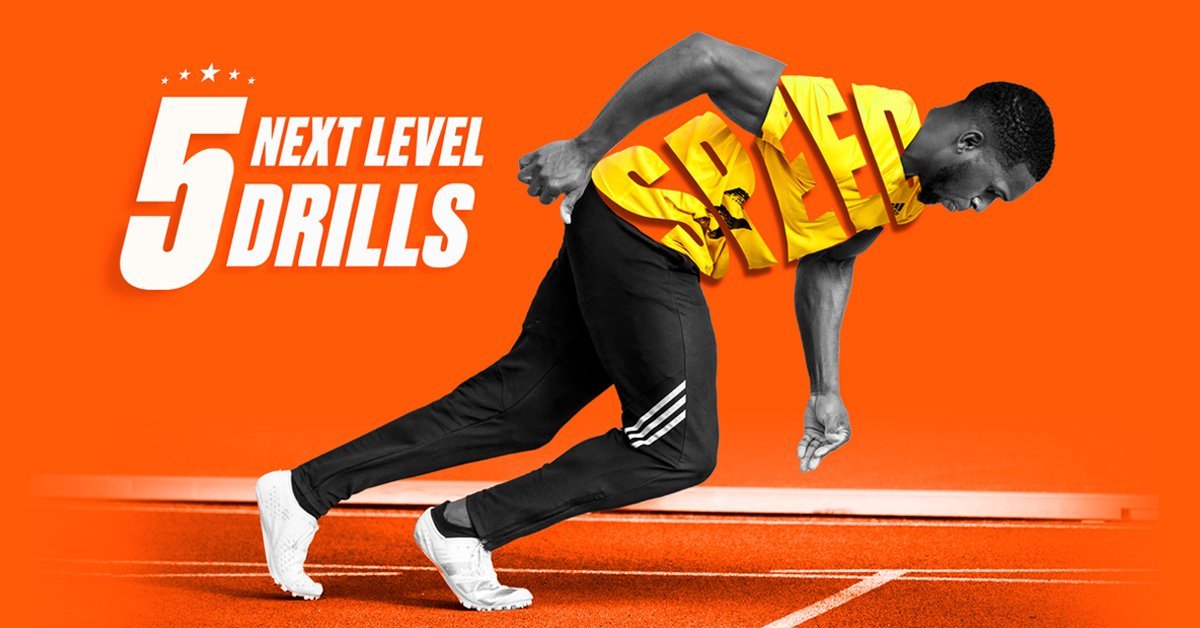
"Sprinting drills don't make you faster. Running fast makes you faster."
If we got faster every time we heard this, we would have broken the 100m World Record by now.
While the statement has some truth, it is disconnected from the reality of kinesthetic learning and skill mastery.
It also fails to address the importance of two fundamental elements of speed development:
#1 Sprinting Technique - An athlete can only run as fast as their technique allows.
Technical speed development requires a series of sensations that establish correct motor pathways.
Attempting to learn all of the technical elements of speed while moving at top speed is like learning to drive at 90mph.
Slowing down and focusing on specific aspects of technique with sprinting drills is far more effective. It will also help to eliminate poor sprinting technique.
When performed correctly and repeatedly, movement patterns create more efficient neuromuscular connections. The opposite is also true.
If you keep trying to run fast with poor form, you will build stronger neuromuscular connections to slower movement patterns.


#2 Sprinting Power - Speed comes from power.
Unlike distance running, where endurance and aerobic capacity take center stage, sprinting relies heavily on technique and the ability to generate maximum force with each stride.
While being strong and powerful is essential for sprinting, maximizing speed requires training the body to efficiently transfer that strength and power into forward motion.
This involves developing the coordination, technique, and neuromuscular connections necessary to convert strength into forward propulsion.
Effective sprinting drills train the body to improve the rate of force development (RFD), which is the ability to generate force rapidly.
This allows sprinters to apply high levels of force in a short amount of time, resulting in explosive starts, quick acceleration, and minimal deceleration during max velocity.
However, it's essential to recognize that proper recovery plays a vital role in maintaining power and speed during sprint training.
If you sprint at max effort for multiple reps without proper recovery in between, you will lose power with each sprint. You will slow down. Which means you will begin practicing that slower speed.
And your body will remember that slower speed.
If sprinting is your only form of sprint training, you won't be able to sustain your power output. Not only will you leave speed on the track, but it's also a great way to get a sprinting injury.
Sprint drills (done correctly) will absolutely make you faster. There isn't a single elite sprinter who hasn't done thousands of hours of speed drills.
But drills are just a component of a sprint training program. Obviously, you must also practice sprinting fast frequently to improve your speed.

WHAT YOU SHOULD KNOW ABOUT SPRINT TRAINING
In the first section of this article, you'll learn the critical components of sprinting drills. So when you're scrolling through Youtube or Instagram, you can weed out the attention-seeking drills from the advantageous ones.
If you're just here for the high-octane part, feel free to skip to the NEXT LEVEL SPRINTING DRILLS.
How should I train for sprinting?
Speed is about applying force. The fastest sprinters don't reach top speeds by moving their legs more rapidly in the air but by applying greater force into the ground.
How do you apply the most force? Focus on technique. Proper sprinting form is the cornerstone of speed development and running faster. It is the bridge that connects your raw power to the track.
Just as a soccer player kicks thousands of balls or a basketball player spends countless hours shooting free throws, sprinters meticulously refine their technique to unlock their full potential.
Any speed drill worth doing must have a positive effect on form and carry over to the track (or field, court, etc).
Purpose should be the first focus of any exercise you add to your sprint training program.
High-value sprinting drills target specific aspects of sprinting technique, such as stride length, stride frequency, ground contact, body positioning, etc.
Remember, the purpose-driven approach is about being intentional with your training choices. It means carefully evaluating each exercise's potential benefits and ensuring they align with your experience, individual response to training, and overall sprinting goals.
Avoid adding drills simply for the sake of variety or novelty (or number of likes on Instagram).
The drills we've shared below are not quick fixes with instant results (no exercise is). You will not get fast overnight. Speed takes time.
If you consistently put in the work they can fine-tune your movement patterns to the extent that they become automatic, enabling you to achieve optimal sprinting mechanics and efficiency without having to think about it.
Once an athlete becomes proficient at sprinting drills for beginners the drills in this guide will absolutely help take them to the next level.

What exercises improve sprint speed?
There is no shortage of sprinting drills that coaches and athletes can include in their training.
The challenge becomes selecting the right mix of exercises that target the most important elements of speed development and performing them correctly.
Sprinting drills contribute to your speed and endurance in different ways:
- Skipping drills reinforce proper mechanics.
- Coordination drills strengthen the neuromuscular connection.
- Sprint-start drills sharpen reflexes and improve your speed and reaction.
- Max velocity drills increase acceleration.
- Plyometrics boost power.
When designing your sprint training plan, choose the drills that will help you reach your goals most effectively, and that can be performed correctly and consistently.

What can I do to avoid sprinting injuries?
If you're eager to improve your speed, jumping right in and trying every drill across your social media feed can be tempting.
This is a terrible idea.
There isn't a singular "secret to speed." Getting faster results from practicing the right things with the right timing, intensity, and focus for each athlete.
If you try to progress too quickly or perform sprinting drills that are too advanced, you will harm your form and your health. Being sidelined with a sprinting injury is the quickest way to slow you down.
Usain Bolt and Carl Lewis, widely regarded as the greatest sprinters in history, share a remarkable trait beyond their divergent techniques and training styles: they consistently prioritized their physical well-being by striking a delicate balance between pushing their limits and avoiding the risk of injury.

Their awe-inspiring feats on the track, spanning multiple Olympics, were a testament to their unwavering dedication to injury prevention. By prioritizing their physical well-being, Usain Bolt and Carl Lewis created the foundation that enabled them to compete and dominate at the highest level of track and field for well over a decade.
Here are the critical components of safe sprint training:
- Make sure the drills and exercises are appropriate for your fitness level and goals.
- Warm up thoroughly using proper form. You will run in the same way that you warm up. As you prepare for your workout, pay attention to posture, arm swing, foot positioning, etc.
- Start slow and build intensity and duration only after you or your athletes can perform the drill correctly.
- Rest between reps. To get the most out of your sprint training, you must allow the body to recover after each repetition so you have enough energy to perform the next correctly. Since the following drills are not done at top speed (which requires a higher work-to-rest ratio), the work-to-rest balance should be at least 1:3. If you spend 30 seconds on a repetition, rest for at least 90 seconds before starting your next. This can include simply walking back to your starting place and refocusing mentally to begin the next rep.
- Listen to your body: Instead of adhering to the outdated belief of "no pain, no gain," recognize that pain (distinct from fatigue or normal muscle soreness) is your body's way of signaling that something isn't quite right. Paying attention to these warning signs and acknowledging the messages your body sends can help you prevent potential injuries and maintain a healthier approach to sprinting.
How often should I do sprinting drills?
The correct answer to this question is based on an athlete's skill level, training experience, fitness, and goals. It will also depend on the time of year (in-season or out) and the training phase the sprinter is in.
A first-year high school student, a master's sprinter, or an elite college athlete all have different training requirements to reach their goals. Similarly, no two professional sprinters will train exactly the same.
For a beginning or young sprinter, 2-3 days per week with at least 24 hours of rest between sessions is a good starting point.
An athlete with moderate sprinting experience in the competition phase of training might do sprinting drills three times a week, depending on their particular focus.
For an advanced athlete in the event-specific training phase, 5-6 days a week is typical.
While seeking a one-size-fits-all plan for speed development is tempting, this approach will likely result in injury or muted results. Individualizing and tailoring your training to your unique strengths and weaknesses is necessary to achieve maximum speed.
The Most Effective Online Sprinting Course.
Explore CourseHow many sprint drill repetitions should I do?
Again, the unsatisfying answer is it depends.
If you're doing a specific drill for the first time, start with one or two repetitions at 15 meters.
The goal is quality, not quantity.
Once you are confident that you are performing the drill correctly, you can increase the speed, repetitions, or distance. Performing a single exercise 3-6 times for 15-30 meters is typical.
The number of unique sprinting drills an athlete does in a training session should be based on their focus and goals for the particular training session.

5 NEXT-LEVEL SPRINTING DRILLS
We selected five of the best sprinting drills from our top selling sprint courses.
The following drills are exercises in skill. It's vital to focus on form rather than speed. Start slow and perfect your technique before turning up the pace.
These drills are not for beginning sprinters. They are advanced sprinting drills.
If you or your athletes are young or inexperienced, start with fundamental sprinting drills like skips, acceleration progressions, and wall drills.
If you're new to speed training, you can learn a ton of fundamental sprinting drills and speed technique in our Smarter Athletic Speed course.
A-SKIP VARIATIONS
The A-Skip is a foundational sprint drill typically done during the dynamic phase of a sprint training warm-up. The basic form of this drill reinforces proper sprinting posture and efficient foot contact.
If you're unfamiliar with the A-Skip, the following drills are too advanced. Before attempting to practice any variation of this drill, you should feel absolutely confident in your A-Skip.
The first three drills take the A-Skip to the next level and multiply the positive reinforcement of proper technique and improved force application.
Drill #1 - A Skip with Med-Ball
Why it works: This A-skip variation changes your center of mass slightly, so you must work harder to maintain positioning with the hip girdle.
Drill #2 - A Skip Pause
Why it works: This A-skip variation helps to "clean up the nervous system" and improve fluency. Because the more fluent you are, the faster you'll be.
Drill #3 - Double A Replacement
Why it works: This highly effective sprint drill primes the nervous system to perform speed work while improving running technique and sprinting mechanics.
Drill #4 - The U aka The Miami Drill
Why it works: If you want to run fast, focus on frontside mechanics. Good frontside mechanics result in improved speed and power. This is an excellent drill for working on frontside mechanics.
Drill #5 - Advanced 1-2-3
Why it works: This advanced pre-acceleration drill is a powerful way to develop proper technique, rhythm, and timing.
SPRINTING TIPS FOR IMPROVING SPEED:
The secrets to speed are simple. It's the execution that's hard.
- Consistency. Profound improvements in performance are achieved by consistent, modest gains over time.
- Focus on proper form. Always.
- Don't skip the warm-up. Ever.
- In regards to training, start slow and finish fast. Build intensity and speed as you progress through a workout.
- Hydrate.
- Eat healthy, nourishing food.
- Sleep. Athletes typically need more than most.
- Repeat.
To learn more of the most effective drills, technique, and sprint training, check out our best-selling sprint courses: Speed Progression.








Great example of sprinting the right way and the wrong why also I like the way you explain your warm up drills.
Appreciate it John!
learn a lot from this video Iam having an academy team of 15 athletes which have attended the Oceania athletics championshipin Fiji this year, Iam based at the National sports institute, in PNG. Iam a IAAF level one coach but this has been very helpful, athletes don't do enough of these drills so I have made it a must for them to do it
It's great to hear that you found it helpful. Kudos to you and your team for attending the Oceania Athletics Championship in Fiji! Implementing these drills will surely make a difference. Keep up the fantastic work at the National Sports Institute!